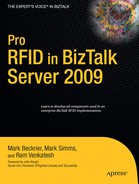This book is for solution architects, application developers, and IT administrators involved in the development and deployment of a Microsoft BizTalk RFID solution. We address both ends of the spectrum: if you are an RFID solution integrator who wants to learn about deploying solutions based on Microsoft BizTalk RFID, or a Microsoft solution provider who wants to learn about integrating and leveraging RFID technology, this book is for you. To do this effectively, we use a hands-on approach with plenty of exercises and conceptual material, and assume no significant prior exposure to Microsoft BizTalk RFID.
How This Book Is Structured
The intent of this book is to introduce the different aspects of working with BizTalk RFID in the most logical manner possible. The nature of the product lends itself to a linear storyline, rather than a more compartmentalized approach common in programming languages and broader platforms. Because of this, it begins with foundational topics and moves through advanced build and communications, enterprise integration, debugging, and deployment—the same flow as would be seen in a typical BizTalk RFID project.
Chapter 1: We begin with an overview of RFID, the history of the technology, and its role in the marketplace. BizTalk RFID will make much more sense when the full story of RFID is understood.
Chapter 2: We introduce the fundamentals of the BizTalk RFID application, in order to make you aware of the overall scope of the product before trying to develop any single component.
Chapter 3: Digging into actual development, we introduce a “Hello World” application, illustrating the key concepts needed to build more advanced solutions.
Chapter 4: BizTalk RFID Manager is central to the administration and configuration of solutions. This chapter details how to work with and extend the administrative functionality of the application.
Chapter 5: Understanding how to work with the flow of information from RFID devices is the theme of this chapter. The fundamentals of communication and interpretation of this data are critical aspects of component development.
Chapter 6: Continuing on the concepts introduced in Chapter 5, event handling and processing is explored. The discussions and exercises in this chapter introduce how to extend the communication patterns.
Chapter 7: BizTalk RFID Mobile revolutionizes the way RFID solutions can be deployed and maintained, moving core functionality to mobile devices. This chapter explores this aspect of the technology, including how to successfully incorporate it into an organization.
Chapter 8: BizTalk Server is separate from BizTalk RFID, yet there are many mechanisms that exist that allow for the easy integration of the two. Incorporating orchestrations, ports, data mapping, and other integration concepts are the core concepts discussed in this chapter.
Chapter 9: Integrating with other enterprise applications is essential to many BizTalk RFID solutions, and this chapter outlines some of the more common scenarios that developers will encounter, including those involving SharePoint web parts and SQL Server reporting. These applications can be interacted with directly from BizTalk RFID, or using the more robust functionality of the core BizTalk Server engine.
Chapter 10: Debugging and diagnosing solutions is a ubiquitous need, and this chapter explains in detail the options that are available to the BizTalk RFID developer. Performance counters, log files, and exception handling are all discussed in detail.
Chapter 11: This chapter walks through the process of deploying a BizTalk RFID solution to a production environment, and discusses the many considerations needed in a successful deployment.
Chapter 12: There is such a vast array of BizTalk RFID solutions that there is no way to capture all of the concepts that may prove valuable to a reader. This chapter, however, introduces various ideas that may help developers and architects better understand how to deliver and extend the functionality of a solution.
Prerequisities
The exercises in this book assume that you have access to BizTalk RFID and Visual Studio, and can compile and deploy to a development system. The exercises also assume that you’re working with BizTalk Server 2009—though most examples will work with BizTalk Server 2006 R2. Some discussion and analysis centers on other systems, such as SharePoint 2007 and SQL Server 2008, though these are not essential to understanding BizTalk RFID.
Downloading the Code
Much of the code used in the exercises in this book is available at www.apress.com in the Books/ Source Code section. (You can also find the source code for any book in the Book Extras area of the book’s page.) All examples in this book can be built without the downloadable code.
Contacting the Authors
Feedback and comments are appreciated, and the authors can be reached via the following addresses:
Ram Venkatesh:
[email protected]Mark Simms:
blogs.msdn.com/masimmsMark Beckner:
[email protected]

